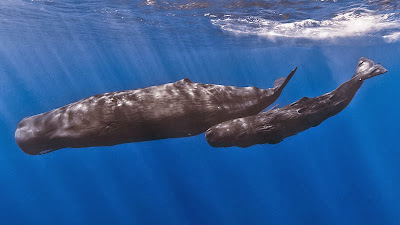From my salon I watch the passing of the long 18th century, setting quill to paper now and again to tell tales of the glorious Georgian era. The story I'll share today is one of man versus nature and inspired a famed Victorian study of revenge, obsession and the great white whale.
Under Captain George Pollard, Jr. and First Mate Owen Chase, the whaleship Essex left Nantucket on 12th August 1819. Its long and successful career had left the craft with a reputation for good luck and those on board looked forward to a fruitful two and a half years sailing the Pacific Ocean.
From the start the voyage was not happy, blighted by storms and discord amongst the crew, particularly between Pollard and Chase. There were few whales to be found and when lookouts sighted a pod of sperm whales early on 20th November 1820, excitement gripped the vessel as the crew made for their whaleboats to give chase. A furious pursuit followed and as the whaleboats closed in on the pod, Chase laboured on board the Essex to repair his own damaged craft. As he worked he and his fellow sailors saw a whale that they estimated at 85 feet in the vicinity of the ship, barely moving.
The whale's strange behaviour caught the attention of the men and as they watched it circled away from the ship before moving towards them, its pace increasing as it closed in. The creature rammed the Essex and dived beneath the waves, leaving the vessel listing dangerously from side to side.
The whale resurfaced, swimming ahead of the ship before it turned and hurtled towards the vessel at a speed that filled the crew with terror. Its enormous tail thrashing in the waves, the creature slammed headfirst into the Essex and ploughed straight through the bow, turning it to matchwood. As the crew gathered what few provisions they could the whale turned and disappeared once more beneath the surface of the Pacific Ocean. Terrified that the creature might return, the sailors piled into the whaleboats and fled the Essex as it capsized and sank beneath the waves 2000 nautical miles from the coast of South America.
For the crew of the Essex, the whale's attack was only the beginning of their suffering. With the food quickly ruined by seawater and no land in sight, members of the crew began to die of thirst and the conditions at sea. When they finally reached land it was the uninhabited Henderson Island, just over 100 miles away from Pitcairn, where they might have found sanctuary amongst the survivors of HMS Bounty. Eventually they took to the sea again, turning to cannibalism of their dead comrades as the weeks passed.
In total, only eight of the crew of 20 survived including Pollard and Chase, who wrote his own account of the sinking, The Narrative of the Most Extraordinary and Distressing Shipwreck of the Whale-Ship Essex. Both men returned to the sea yet neither ever fully recovered from the memory of that terrible ordeal and Chase in particular suffered terrible torments, with the former First Mate committed to an institution in later life.
And what of the creature that sank the Essex? Well, the whale never repeated its attack or if it did, no men lived to tell the tale. The memory of that whale lives on today though, immortalised forever in Herman Melville's classic tale of the whaling world, Moby Dick.

5 comments:
Incredible story - the revenge of the whale!
Liz
It certainly gave them what for!
I know who to blame if there are nightmares tonight,Madame!!
It's certainly a score for the whale!
According to David Attenborough and his amazing Blue Planet 2 series, the sperm whale has the largest brain on earth. It is amazing that more of them have not tried this over the years. Lots of other creatures charge when threatened and the early whalers were incredibly vulnerable to attack in their flimsy rowing boats and wooden ships.
Post a Comment